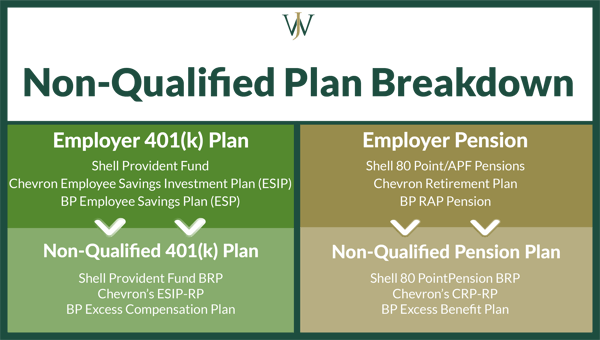Upon reaching a certain level of income, many of Houston's oil and gas corporations may provide additional employer-sponsored benefits (often known as non-qualified retirement plans) that can be significantly more complex than a typical 401(k) or pension. When your income begins to exceed the IRS' income limitations for pensions or 401k contributions, additional rules and considerations surrounding these plans need to be evaluated and planned for to make sure you don't set yourself up for a hefty tax bill at retirement. The best way to avoid this tax hit is to know how these plans work ahead of time and to choose the proper elections for your situation accordingly, which is what we'll dive into below.
What is a Non-Qualified Retirement Plan?
If you have a retirement savings plan with the words ‘Excess Compensation’, ‘Excess Benefit’, ‘Benefits Restoration’, or something similar in the title, you may have a non-qualified retirement plan. Employers establish these non-qualified retirement plans to circumvent the Internal Revenue Code (IRC) Section 415 limitations so that the organization can continue making contributions on behalf of the high-income earning employee to these plans for retirement. The IRS has limitations on both pension and 401k contributions, so we see many companies create non-qualified retirement plans to restore benefits for these high-income earners for both plans.
Learn How To Shift Your 401(k) Contribution Strategy
Around These Income Limits Here >>
Non-Qualified 401(k) Plans
The IRS rule limits both you and your employer’s contribution to your 401(k) based on the first $305,000 of income for 2022. This means that you and your employer can only make contributions to your 401(k) based on the first $305,000 that you earn. When your income exceeds the $305,000 limit, neither you nor your employer can contribute any more money to your 401(k). Large corporations often want to continue their matching benefit for employees who have income that exceeds this limit. They do so by establishing a non-qualified defined contribution plan and depositing the excess matching contributions there. These funds can be invested and grow until the employee’s retirement or departure from the company.
The common ones we see are:
|
Shell |
|
|
Chevron |
|
|
BP |
How a Non-Qualified 401(k) Is Funded After Reaching the IRS Limits
Let's suppose that your employer has a non-qualified 401(k) for you, as you've been deemed a high-income employee earning $550,000 of total eligible compensation (salary & bonus) for the year. The IRS income limits for 2022 prevent both you or your employer from contributing to your qualified (or regular) 401(k) after you reach $305,000 of income. Once your income exceeds the $305,000 limit, neither you nor your employer can contribute any more money to your typical 401(k), so your non-qualified 401(k) plan acts as an additional bucket for your company to deposit any of the contributions they would’ve made on your behalf to.
Let’s consider an example:
Let’s say your company contributes 10% of eligible compensation to your retirement plans in a given year. You, an employee making $550,000 a year in salary, also receive a $50,000 bonus in February, which makes your total eligible compensation $600,000.
When you reach $305,000 in eligible compensation, your organization will have contributed $30,500 to your 401(k) and cannot contribute more; however, as a high-income employee, you're "owed" a total of $60,000 in contributions to fulfill the 10% matching benefit. Therefore, your company would put the remaining $29,500 of contributions into your non-qualified plan to ensure that you received your full non-qualified 401(k) benefit.
Non-Qualified Pension Plans
In a similar way, the IRS also limits an employer's contribution to their employee's pension. The pension benefit for someone working until their full retirement age cannot generate a pension benefit exceeding $245,000 in today's dollars. Once the contributions to an employee's pension reach this threshold, the employer can no longer contribute to a qualified pension plan and must either contribute to a non-qualified plan or forego the employee's additional benefits. To understand how this works, let's look at how pensions are typically calculated.
A common formula many large oil companies use to calculate pension benefits is:
1.6% * Years of Service * Average Final Compensation (AFC)
Let's assume, using the same example from earlier, that your pension calculation would look like this:
1.6% * 30 * $600,000
Your pension benefit would be approximately $288,000 for 2022, exceeding the $245,000 IRS limit by $43,000. The funding for the projected $43,000 pension benefit will be contributed to the non-qualified pension plan to ensure that you receive your full benefit
To retain top talent, large companies often want to continue bolstering an employee's pension after they reach the IRS threshold. Establishing a non-qualified pension plan and depositing the excess contributions there offers an employee substantial savings to draw upon in retirement.
The common ones we see are:
|
Shell |
Shell 80 Point Pension Benefit Restoration Plan |
|
Chevron |
|
|
BP |
Post-2004 Excess Compensation Pension Payout |
How Non-Qualified Retirement Plans Impact Taxes & Retirement
While many employees with these plans get excited about the additional retirement benefits they offer, there are a few key considerations to keep in mind about how they work.
Understand the Default Payout Elections & Common Payout Alternatives
Typically, if an employee makes no alternative elections, non-qualified retirement plans payout immediately as lump sums and are taxed at ordinary income rates upon retirement. Receiving all of the proceeds from the non-qualified plan in the year of retirement can cause a substantial portion of this payment to be taxed at the highest marginal income tax rate. Without proper planning, you may be paying more taxes than necessary.
For example, if you receive a $400,000 lump sum non-qualified payout, you will be in the higher marginal income tax brackets, especially assuming $100k of other income, either a pension, investments, etc.
Annuitization
A common alternative to the lump sum option is to annuitize (or distribute the payment) over several years. Annuitizing these large lump sums can be a beneficial way to space out income and lower your taxable income in high-income years surrounding your retirement. Not every company allows these plans to be annuitized at distribution, so it's important to discuss your options with your organization's Human Resources department and make the elections early if they're available to you.
Let's return to our previous example. Suppose you receive a $400,000 non-qualified payout and you chose to annuitize the payment over a 10-year span. Doing so would put you into the 22% marginal income tax bracket instead of the 37% marginal income tax bracket, which would provide significant tax savings on the total payout.
Annuitization & Deferral
In addition to annuitization, sometimes companies will allow you to defer the payout for several years before annuitization. This can be a huge benefit that allows you to take advantage of moving large amounts of income to low-income years to further capitalize on tax savings.
Effectively Timing Payout Distributions Can Lower Annual Taxable Income After Retirement
From a tax perspective, non-qualified plans can be the difference between staying in the lower tax brackets or getting bumped into the highest tax brackets. For those hoping to retire near the end of the year, say the end of the third quarter or the very beginning of the fourth quarter, the tax burden from these plans can easily push an employee up several brackets.
Consider this, for those retiring near the end of the year, you've earned three-quarters of your salary, you’ve probably received performance shares and your prior year’s bonus, and you’ve also probably earned a prorated bonus for the current year. Along with the other retirement payouts you’ll receive by the end of the year (including these non-qualified plan payouts, unused vacation, and potential severance payments), you could end up being taxed at the max rate of 37% on these earnings and benefits, which can devour a huge portion of your retirement income.
By contrast, if you choose to retire on January 1, it may make better financial sense. By pushing out your retirement date, you don't have the high amounts of regular income on top of the non-qualified plan payouts which can put you in a better tax position by removing your base income from your tax calculations for the year.
Learn More About Timing Your Retirement From:
What Should You Do When Managing Your Non-Qualified Retirement Plan?
Different companies have different rules regarding payout elections for their non-qualified plans. For example, some Shell clients were required to have made their elections prior to 2009 in order to annuitize the payout of their Benefit Restoration plan. We find that other companies, such as BP, allow their employees to make the election for a payout of their non-qualified retirement benefits at the beginning of each year. We proactively assess this payout decision with our clients to create a plan that manages cash flow needs in retirement and minimizes their tax impact.
With proper planning, these plans can be a very useful tool to help provide income in the first few years after retirement. If you have one of these plans, we recommend you speak with a professional advisor, like Willis Johnson & Associates, who specializes in helping corporate executives and professionals minimize taxes and maximize their company benefits.










